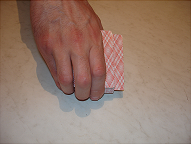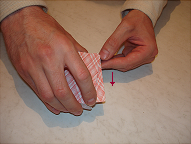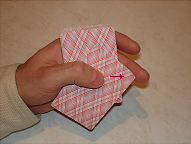Control of the selected card (5 ways)
The control of the selected card means that wherever cards are in the deck you always know where they lie, that is, these cards are under your constant control. There are 4 popular ways of this control.
The first way (using Hindu shuffle). This method is used to control, for example, the three cards that viewers selected and which you transfer to the top of the deck, without using volts or different shuffles.
Take a deck of cards, fan it and ask three spectators to choose one card. After the audience selects and remembers these cards, then approach each of the spectators and begin to do an Indian shuffle . When a small card package is in the left hand then you are holding it out and offering the first viewer to put his card on the package. Then go to the second viewer, continuing the shuffle. In fact, something else is happening. Once you have the remainder of the deck that you hold in your right hand, carry over the package and your left hand, then grab the top 5 or 6 cards of the package in your left hand with the big and middle fingers of your right hand and place them under the remainder of the deck in your right hand, at that moment your fingers The left hand draws several cards from the remainder of the deck in the right hand to the bag that is in the left hand. Capture a couple of cards at a time, but in no case is only one card. Next, shuffle the next few cards from the top of the package that is in your right hand to the cards that are in your left hand while you approach the second viewer. When you do the last shuffling movement, then you do not pull the cards from the package into the right hand, but lower the previously unconsciously captured cards from the right hand to the card package in the left hand, on top of the map of the first spectator. Then again shuffle the cards, fold the top cards from the package that is in the left hand. Then go to the third viewer, drop the folded cards on the package in the left hand and on the second spectator card and take the third spectator card. After this, bring the shuffle of cards to the end, first by folding the top cards of the package, which is in the left hand. At the end of the shuffle, the cards that are selected by the spectators are on top of the deck, although the viewers believe that the cards that were put by them are in different places in the deck and are shuffled reliably.
The second way (control-throw). Take a deck of cards and ask the viewer to choose any card. After the viewer selects the card, divide the deck into 2 packages and ask the viewer to put the card he has chosen on the bottom package. The lower packet lies in the left hand, located longitudinally. The second package is in the right hand. The card is returned, and the front narrow edge of the bottom packet is slightly tilted down to the floor. The right hand moves the second half of the pack up and holds it over the left hand at about 15-20 cm and slightly behind. The front narrow edge of the right packet is slightly inclined downward, only at a greater angle than the left packet. While saving these corners, release the right packet, or rather throw it at the bottom packet. This movement-throw must be accompanied by a slight movement forward of the left hand. If this movement is carried out correctly, then the narrow end of the upper pack should strike at an acute angle in the middle of the lower pack. The photo shows the position of the packages at the time of their meeting.

As a result, all the cards in the package, including the single card of the lower packet, slide forward and hit the index and middle fingers opposite the outer narrow end of the packets, except for the top card of the top packet. This card does not slide along with the other cards forward, but rather protrudes from the outside somewhere 5-6 mm from the side of the back narrow edge.

At the moment when both bags converge, the tip of the left thumb of the left hand guides the pack up so that it can be seized between the first phalanx of the thumb on one side and the second phalanx of the little finger on the other side of the long side. In this case, the index and middle fingers are located at the outer narrow edge of the deck. The unnamed finger is in the middle of the right long edge opposite the thumb. At the moment when the deck is thus captured, then sharply tilt your left hand down and simultaneously, making a sharp move forward. All the cards except one are aligned, slipping, to both fingers with an outer narrow edge. The only exception is the map, which previously lay on the front side of the upper package. This card stands at the back edge of the outside and under it is the map that the viewer chose.
If you analyze this technique, you can see that it consists of three parts.
![]() Throwing the upper package onto the lower bag.
Throwing the upper package onto the lower bag.
![]() Change of the way of holding.
Change of the way of holding.
![]() Lashing forward after tilting the deck, because of which the deck is leveled
Lashing forward after tilting the deck, because of which the deck is leveled
In the process of execution, all these movements must merge into one. After demonstrating this method it is necessary to make a shuffle "Brook". The right hand raises the top of the deck, the card that is serving is the bottom card of the top packet, and the top card of the bottom packet is selected. Make a frame, and the selected card will be the top card of the deck.
The third way (Simon card control). Take the deck of cards in your left hand and ask the viewer to choose any card. After the viewer returns the card to the deck, align it in the left hand and grab the narrow ends between the thumb of the right hand on the back and the rest of her fingers on the front side. The middle and ring fingers lie on the front side of the deck, and the tip of the index finger of the right hand is located on the crest of the top card, the little finger is in the free position. Hold the deck just to the right of her middle, as shown in the photo.

Hold the deck with the left side facing the viewer when you ask him to shove the card halfway through its width into the deck. Your index finger should be positioned so that the card can not be pushed further. Take your hand with the deck from the viewer, make a left hand gesture that points to the card and slide the card further into the deck so that not more than one third of the card looks out from the outside, as shown in the photo.

While holding the pack, pull out your thumb and place it against the bottom corner of the card that protrudes. Then, slide the card forward, in the direction of the arrow, as shown in the photo. When you finish this move, swipe your thumb along the long edge several times forward and backward.
The viewer believes that his card is safely hidden in the deck and that if he does not name it, then it will be impossible to find it. In fact, the map is easy to find if you look at the right side of the deck. This card protrudes slightly at the right rear corner. It is hidden under the fingers of the right hand.
Put the deck on the table in such a way that the card that was projected was turned towards you. At the same time, pull the sleeve back slightly and rub your hands. This movement is necessary for you, that there was an occasion to postpone the deck for a while. This tactic of tightening is needed in order to convince the viewer that you do not control the chosen card. The deck is in aligned state and the viewer is convinced that the map can not be found.
Grab the deck and put it in your left hand in the position for putting cards. The protruding card should still maintain its position. Thanks to the protruding corner, the selected map is constantly monitored by you. Put the tip of the little finger in the left hand in the deck above the selected card, remove half of the deck cards over the gap and put the cards on the table, and on them the bottom half of the deck. The map chosen by the viewer is the top in the deck.
The fourth way. Take the right hand of the deck and hold it by placing your thumb on the front edge, and place the remaining 4 fingers on the back of the narrow edge. Place your left hand from below and drop the cards into it until the spectator stops you. When you stop, move the last fallen card to the right side, with the package held vertically so that the viewer can see this card, the viewer must remember it. At the moment when you move the deck back to the horizontal position, with your thumb pull the top card back and forth, while the card should lie diagonally on the deck. Then the right hand approaches the left hand and puts his packet on the marked card. Under the right hand cover, pass it. Then put the middle finger of the left hand on the corner of the card that protrudes from the right side and push it down, simultaneously take the thumb of the left hand to the side. The card should stand upright. After that, lower the packet from the right hand, the middle finger relaxes the pressure and the card should fall back. Now it lies at the very top.


The fifth method (control by shuffling by scrolling). Before acquainting yourself with the control of shuffling by scrolling, read the section of shuffle by scrolling .
Save the card on top of the deck. After the sublimation, the card that must remain in place becomes the top card of the sub-deck of the deck. Therefore, you must wait until all the cards, say, on the left side of the deck fall before you release the last few cards from the right side of the deck. When you move the pieces of the deck into each other, the required card will be on top of the deck again. 5-6 cards on top of the deck can be saved in the same way, by holding them until all the cards from the left side of the deck fall down. It is not recommended to keep a large number of cards on top of the deck.
Save the card from the bottom of the deck. In this case, the cards are controlled at the bottom of the left side of the deck. In the process of capturing the left and the other fingers, do not take all the cards, but give the small part of the deck to stay on the table and lift only the cards that are on top of it. The first is to drop the cards from the part of the deck in the right hand over these cards. Thus, after the deck has been leveled, the card or cards that are controlled again will be from the bottom of the deck.
Sometimes it may be necessary to add one card from the top of the deck. This is done very simply when shuffling through the scrolling. Raising the corners of the deck part in the left hand, press the index finger on the top card of the deck part and slide it slightly over the thumb of the left hand. Then hold it from the back until the last card from the part of the right-hand deck is released.


Comments
When commenting on, remember that the content and tone of your message can hurt the feelings of real people, show respect and tolerance to your interlocutors even if you do not share their opinion, your behavior in the conditions of freedom of expression and anonymity provided by the Internet, changes Not only virtual, but also the real world. All comments are hidden from the index, spam is controlled.